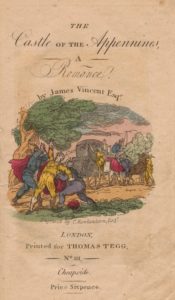
During the height of the late 18th century-early 19th century Gothic literature craze, a cottage industry of bluebooks was born. Some fan fiction, some plagarized, some extracted or retold, bluebooks (named for their flimsy, blue cover) were sold for sixpence or a shilling, or could be had for the evening from the circulating library at a penny a night. The were short, typically 30-75 pages, and were immensely popular with a public thirsty for Gothic horrors, but without the means or the time to read an entire novel (Potter, 2005).
Taking a note from single sheet ballads, broadsides, quackery “books”, political libels and chapbooks, bluebooks emerged around 1790 as a way to meet the demand for gothic romance (Thomas). Their themes were familiar: mouldering castles, villanious characters, murder and romance, but told in quick way, meant to deliver almost instantaneous horror.
The inexpensive printing and the fact that many were thrown away as a cheap thrill, means there are few still surviving, although some have been sourced and reprinted (http://sheffieldgothicreadinggroup.blogspot.com/2015/04/resurrecting-gothic-bluebook.html).
We will be sharing the story of one of the bluebook authors, Sarah Wilkinson, in our next post.
- Potter F.J. (2005) Literary Mushrooms: The Gothic Bluebook. In: The History of Gothic Publishing, 1800–1835. Palgrave Macmillan, London. https://doi.org/10.1057/9780230512726_3
- Thomas, S. Gothic bluebooks: The popular thirst for dear and dread. Retrieved: https://library.unimelb.edu.au/exhibitions/dark-imaginings/gothicresearch/gothic-bluebooks-the-popular-thirst-for-fear-and-dread










